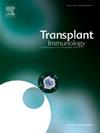高迁移率组盒蛋白 1 基因多态性对活体肝移植后发病率和死亡率的影响。
IF 1.6
4区 医学
Q4 IMMUNOLOGY
引用次数: 0
摘要
我们研究了高迁移率组盒1 (HMGB1)基因单核苷酸多态性(snp)对肝移植(LT)术后发病率和死亡率的影响。在120例肝移植受者及其活体供者中,测定HMGB1基因型和rs2249825、rs1045411、rs1412125和rs1360485的snp位点。这四种snp与排斥反应发生率或死亡率之间没有显著关联。然而,早期的同种异体移植物功能障碍的发病率(EAD) (n = 43),这表现为功能不足1 LT 一周内,明显高于在接受者的GC + CC等位基因rs2249825 (n = 17/34)比那些GG等位基因(n = 26/86)(p = 0.044)。虽然供体HMGB1 snp对EAD发病率的影响无统计学意义,但接受相同基因型供体肝移植的rs2249825 GC + CC等位基因受体的EAD发病率最高(p = 0.052)。相比之下,捐赠者TC + CC的等位基因rs1412125脓毒症的发展是一个独立的危险因素(n = 33)在肝移植接受者(或 = 3.05,95 % CI = 1.18 - -7.87,p = 0.021)。因此,受体或供体HMGB1基因的snp与死亡率无关,但影响EAD和败血症的发生率,可能是肝移植后严重并发症风险的预测性生物标志物。本文章由计算机程序翻译,如有差异,请以英文原文为准。
Impacts of high mobility group box protein 1 gene polymorphisms on morbidity and mortality after living donor liver transplantation
We investigated the effect of single-nucleotide polymorphisms (SNPs) in the high mobility group box 1 (HMGB1) gene on morbidity and mortality after liver transplantation (LT). Among 120 LT recipients and their living donors, the genotypes of HMGB1, and the SNPs rs2249825, rs1045411, rs1412125, and rs1360485 were determined. There were no significant associations between these four SNPs and the incidence of rejection or mortality. However, the incidence of early allograft dysfunction (EAD) (n = 43), which presents as functional insufficiency within 1 week of LT, was significantly higher in recipients with the GC + CC allele of rs2249825 (n = 17/34) than in those with the GG allele (n = 26/86) (p = 0.044). Although the impact of donor HMGB1 SNPs on the incidence of EAD was not statistically significant, recipients with the GC + CC allele of rs2249825 who received liver grafts from donors with the same genotype had the highest incidence of EAD (p = 0.052). In contrast, the donor TC + CC allele of rs1412125 was an independent risk factor for the development of sepsis (n = 33) in LT recipient (OR = 3.05, 95 % CI = 1.18–7.87, p = 0.021). Thus, the SNPs of the HMGB1 gene in either recipients or donors were not associated with mortality but influenced the incidence of EAD and sepsis, likely being a predictive biomarker for the risk of serious complications after LT.
求助全文
通过发布文献求助,成功后即可免费获取论文全文。
去求助
来源期刊

Transplant immunology
医学-免疫学
CiteScore
2.10
自引率
13.30%
发文量
198
审稿时长
48 days
期刊介绍:
Transplant Immunology will publish up-to-date information on all aspects of the broad field it encompasses. The journal will be directed at (basic) scientists, tissue typers, transplant physicians and surgeons, and research and data on all immunological aspects of organ-, tissue- and (haematopoietic) stem cell transplantation are of potential interest to the readers of Transplant Immunology. Original papers, Review articles and Hypotheses will be considered for publication and submitted manuscripts will be rapidly peer-reviewed and published. They will be judged on the basis of scientific merit, originality, timeliness and quality.
 求助内容:
求助内容: 应助结果提醒方式:
应助结果提醒方式:


